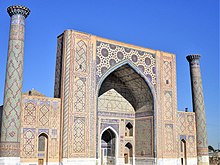Ulug'bek Madrasa (Samarqand)
The Ulugh-Beg-Madrasa is an Islamic college in Samarqand in Uzbekistan . Khan Ulugh Beg built it in 1417/1420; he also built a madrasa in Bukhara (1418) and in Gʻijduvon (1437).
architecture
The madrasa with its mighty portal with a horseshoe arch is prepared for Registanplatz . The corners are equipped with tall, proportional columns. A mosaic panel above the entrance arch was decorated with a geometric ornament. In the square courtyard there is a mosque, classrooms and, on the edge, rooms in which the students lived. Deep niches (corridors) have spread around the axis. Originally it was a two-story building with four domes over the classrooms, which are in the corners of the madrasa.
College life
The Ulugh Beg Madrasa was one of the most prestigious universities in Muslim Central Asia in the 15th century. Ulugh Beg had brought about 70 scholars to Samarqand, including the mathematician and astronomer Jamjid Masʿud al-Kashi and Qadi Zada . The scientist and philosopher Abdur Rahman Dschami studied here.
Ulugh Beg participated in the work of mathematicians at the madrasa and astronomers in the Gurkani Zij observatory, which he built in 1428 . A focus of mathematics was the study of the trigonometric functions that were required to evaluate the astronomical observations. Long unsurpassed results have been achieved by numerical solutions.
Al-Kashi determined the double of the circle number π to 9 sexagesimal places, which he converted into 16 decimal places. He improved the result of the Chinese mathematician Zu Chongzhi , who had calculated 480 7 digits. Al-Kaschi was not surpassed until 1596 by Ludolph van Ceulen , who after 30 years of work had calculated 35 decimal places.
Khan Ulug Beg (and / or al-Kaschi) calculated by numerically solving a quadratic equation sin 1 ° = 0.017452406437283571; today's approximation is sin 1 ° = 0.017452406437283512820 ... Qadi Zada independently obtained the same result using a different method. The tables of the sine and tangent functions with 1 ° increments contained in the Sultani-i-Zidsch are accurate to at least eight decimal places.
During the reign of Ulugh Beg, the madrasa remained a center of mathematics and astronomy . After his murder, the observatory was destroyed. The only evidence of this late bloom of Islamic scholarship remains the star catalog Sultani-i-Zij , whose accuracy was only surpassed by Tycho Brahe .
The madrasa continued as a theological college until the late 17th century. It was then used as a granary and largely fell into disrepair. It was reopened and partially restored in the early 20th century.
Web links
- Article by Bernhard Peter
- Ulug Beg as a mathematician
- Al-Kashi as a mathematician
- Ulugbek Madrasa in Bukhara
- Madrasa in Bukhara
Coordinates: 39 ° 39 ′ 16.8 ″ N , 66 ° 58 ′ 29.2 ″ E

